
This is my first ever blog post. I’ve been considering starting a blog for some time. Looking around at other quilters and quilt teachers, it seemed like an almost mandatory part of being in the biz. I’ve been trying my darnedest to manage the new frontier of social media. The toughest part is keeping up without letting it take over my life. I now have three separate ways to keep in touch with fans, students, other teachers, and friends.
- Website and blog: www.susancarlson.com
- Facebook: www.facebook.com/susancarlson
- Instagram: pink_rhino_quilt
They each serve different purposes: My website is a place where I can always be found. It comes up number one in a Google search of my name. If you want to book a class or buy my book or patterns, that’s the place. Facebook is for those who want to keep up on what I’m doing on a more regular basis: teaching gigs, new quilts, student quilts, travel, and so on. Instagram is more occasional and informal. I use it to share funky and fun stuff that catches my eye.
And now the blog: The blog is for the hardcore quilter. Here I hope to share as freely as I can: technique, inspiration, frustrations, process and theory. If you’re reading my blog, you’re ready to learn more. An occasional Facebook post isn’t enough. Maybe you’ve heard of fabric collage and are intrigued. Maybe you have a question that deserves a longer answer than I can give in an email. If so, the blog is for you.
Since this inaugural blog follows so closely on the heels of the unveiling of my latest quilt, Crocodylus Smylus, I figured I would make that the topic of my first series of blogs. Part one appears below. In the next couple weeks I’ll post parts two and three.
Ӣ Ӣ Ӣ Ӣ Ӣ
The Idea
Where do ideas come from? What makes an idea spark? How does the spark of inspiration light a fire of creation?
In the case of “Stevie,” the first spark of inspiration came from my son’s nature encyclopedia. Reading to him one night I ran across the startling fact that Australian saltwater crocodiles can grow to twenty-feet or more. As I lay next to him in his bed, my son and I imagined how big that is compared to our house. “From here, through the den, into the kitchen.”
I had already done a few large animal quilts: Tickled Pink, Polka Dodo, and Gombessa. And I had a list of other animals I wanted to do: a fruit bat (Fructos) and a Costa Rican golden toad (Million to One), for example. I added saltwater croc to the list.
Opportunity
But an idea doesn’t have a chance of catching fire unless it’s given the opportunity. Sometimes there are life-circumstances that prevent you from pursuing your inspiration.
Assuming one has the skill to pursue such a project, you still need at least two other things:
- Space
- Time
Oh yeah, the old space-time continuum. To boldly go where no one has gone before…
I knew from the beginning that if I ever did a croc, I’d want to make it life size. At the time, however, my studio was a twenty-eight foot diameter yurt. Nice size but round, no wall for such a big project. Fast forward a few of years, though, and I had built a new 32 x 32 foot square studio.
I had space. And a big pinning wall.
Just as important, I was at the point in my career where it wasn’t completely insane to consider spending six months or more to create such a quilt. I appreciate that not everybody can make that choice. It’s a luxury, I know. I figured that if I could concentrate most of my teaching in the winter months, I could have much of the summer and fall to work on the piece.
I had time.
I had no more excuses.
Beginnings
How do you eat an elephant? Bite by bite.
For me it starts with a little research. What does a saltwater crocodile look like? Google to the rescue. I collected some pics. (Taking care to avoid copyrighted material.) Drew some sketches. Drew some more sketches. Threw some of those away. Did a scale drawing.
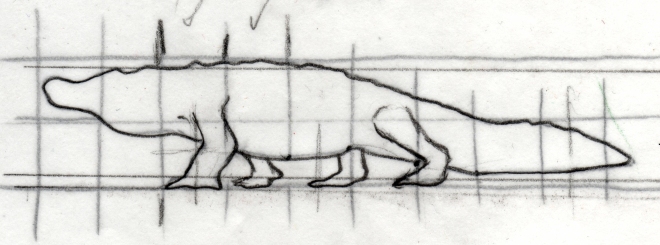
In the meantime, my husband Tom extended my pinning wall. When we designed the new studio, we left fourteen feet of the western wall to be a pinning wall.
Quoth Tom: “That ought to be big enough for you.”
Oh, foolish mortal.
A twenty-foot crocodile demands a twenty-foot pinning wall. He eventually extended the styrofoam board to a full twenty-four feet to account for the background, which would be bigger than the croc herself, of course.
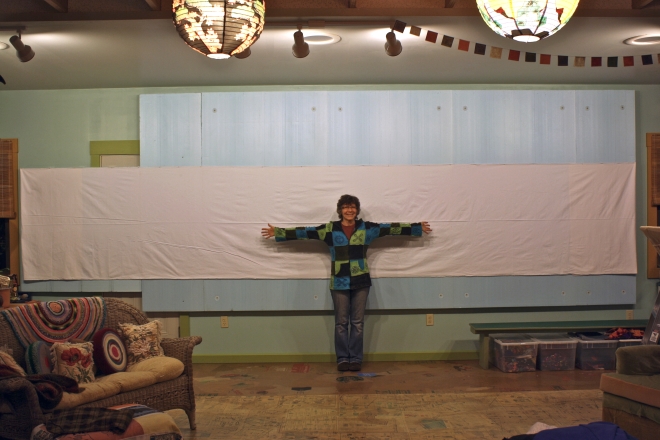
After pinning a piece of flannel to the pinning wall, I transferred the scale drawing to the fabric. I used a grid to go from a ten-inch sketch to the full-size piece. Once the outline was there, I drew in a few details, especially around the head.
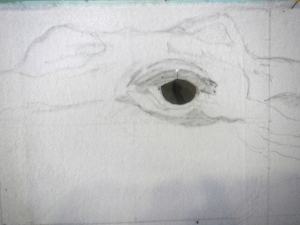
I began with the eye. Here’s a summary of my technique:
- Freehand-cut fabric to size.
- Pin in place. Repeat steps one and two again and again.
- When satisfied, tack in place with craft glue.
- Continue until image is complete.
- Quilt and bind.
That’s really all there is to it. Complicate it however you want, but that’s the bare bones. That’s how the eyeball above became this:
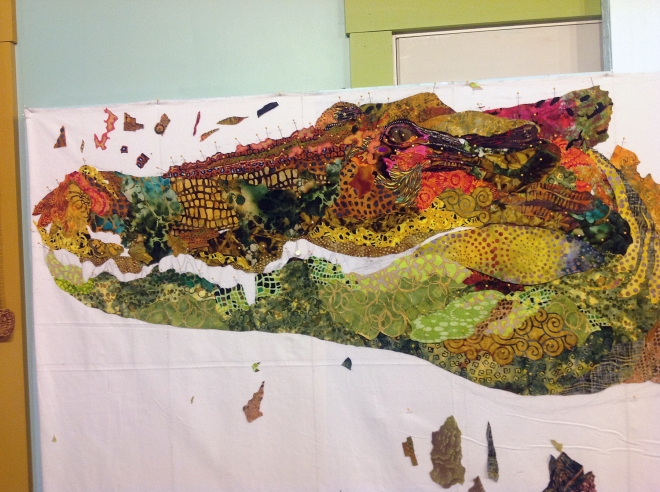
A journey of a single step begins with a thousand miles… wait a minute. Actually that makes sense–to me anyway. My students often want to know where do I start? There is no start. Or are you continually starting? When did I start making the crocodile? When I placed the first piece of fabric for her eye? When I drew the first sketch? When I first read about saltwater crocodiles in my son’s nature encyclopedia? Or was it even earlier? When I first grabbed a glue bottle instead of using traditional methods? When my mom showed me how to sew a stitch?
The point is, a work of art is the product of everything that came before: all your experience, all your technique, all your knowledge.
I have already started my next piece. Wonder what it’ll be…
Continued in Part 2 of 3
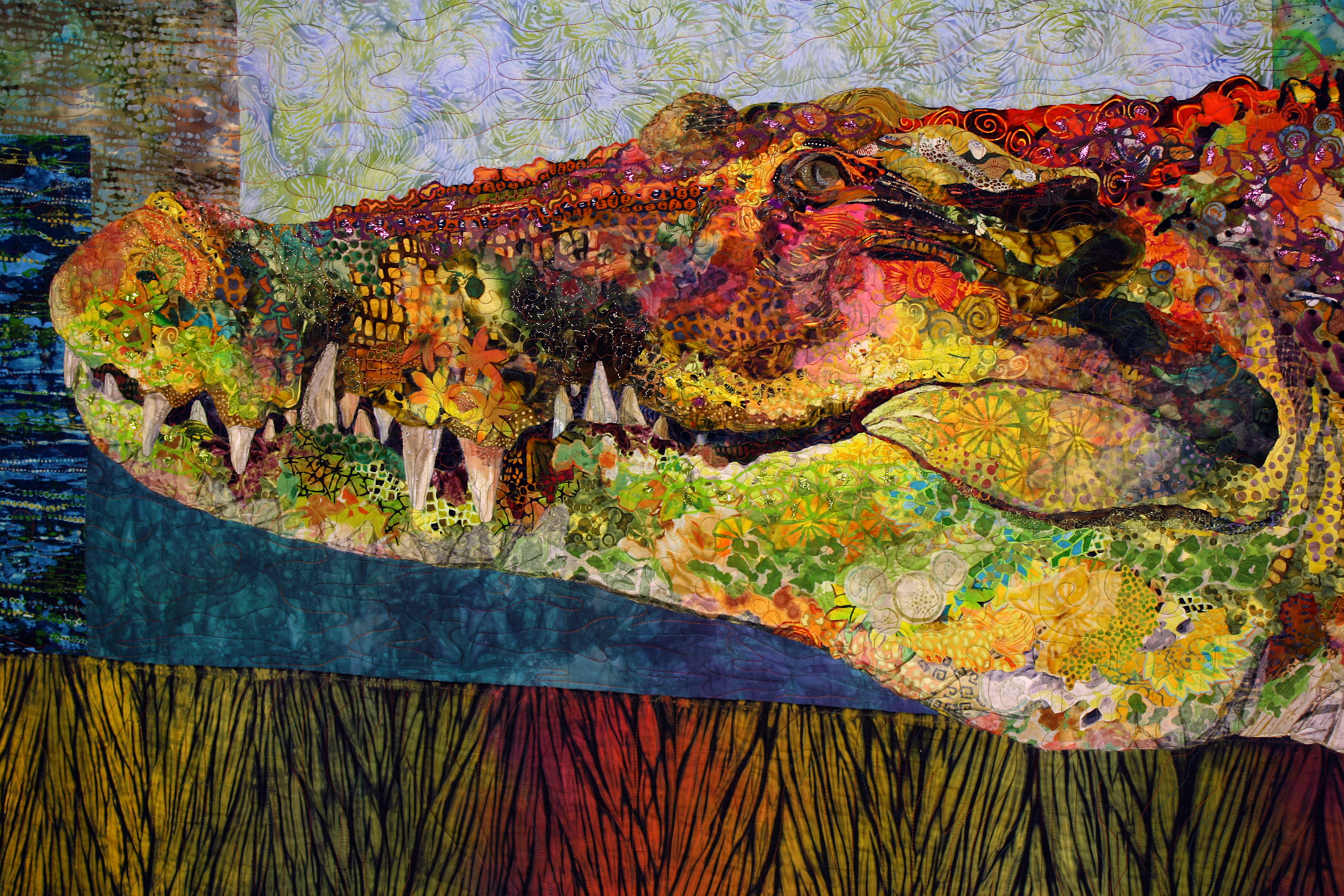
Thank you! I so enjoy your work.
I for one am excited to follow your Blog Susan…I have been an admirer of Stevie and her ‘evolution’ for sometime now. Thankyou! Cindyt
love your work – I also have ideas brewing for a very long time before I start!
I can not wait to read more about Stevie and everything else in your blog. I love your work, it is amazing!
taking another workshop with you is on my list but this time I want it to be a multiple day workshop.
I love your process and all the wonderful creations you make
Love the blog! Looking forward to the next one!
Thank you…. Success on your blog.
You’ve proved to me you are the one Blogger I’ve needed. Your reader in WI and sometimes AZ. If you want to explore desert bione… just ask. Great quilters…. I met An especially perfectionist, = to your drive, Native American portrait quilter. We have a big rental, extra Murphy bed … big home. Warm Jan./Feb… If Escape of Maine is needed?
Thanks for the offer! Maybe I’ll take you up on it someday. Having just started this blog I have a technical question I’m investigating. Did you click on the “follow” button? If you did, how hard was that to do? What was the process? Did it make you sign up for a blog on WordPress? I’ve received some emails complaining about that…
I like how you described the beginnings of your project. Love your quilts, have both of your books, and will one of these days have a spot of inspiration and act on it.
Susan, I’m looking forward to your blog where you get down to the nitty gritty of your creative process. when I read of others’ process it encourages me to keep acting on my own process and stretch to find new ways to interpret what I feel compelled to create. My pieces are natural and realistic and I feel a bit intimidated by the abstract pieces I see around me but I know what speaks to me. I would like to make the leap to translate the actual colors to the bright and fanciful as you did with Croc. That would be my next step. Will you be talking about how you translate your color values to the palette you have? It’s wonderful! For now I can’t ‘see’ beyond the real coloring.
What a great idea for a future blog post! How do you translate natural colors to fanciful ones? A hint to start with: it’s all about values. I’ll elaborate later, but one trick is convert the image you’re working from to black and white. Then you can pick whatever palette of colors you like, concentrating on matching value for value. If you’re having trouble seeing the values of the colors of your fabrics, lay them out and take a black and white photo of them. That should make the fabric values more obvious.
Plus you can write! Thank you, look forward to more posts.
Woo hoo, enjoyed your first blog and do continue to admire your imaginative work. Your expertise in value is amazing. You are the queen!
Thank you! I love your work, so interesting!!!
This is the first blog I have ever followed:). I find Stevie amazing and am looking forward to part II.
I love your work, taken one of your classes, and I too started on the eyes of my dog, Ben. It was a wonderful journey and I know you will always continue to inspire me.
“There is no start” has been an amazing revelation to me…so thanks Susan. You are an inspiration!! If only I was closer… I clicked “follow” and was taken to signing up on WordPress too, so I retreated as I wasn’t sure what to do.
Others had that same problem. I had my hubby/webmaster change it so that you can sign up with your email. It should be working now. If it isn’t, reply to this comment.
Glad you liked it.
Following was easy Susan. I put my email address in the box, clicked follow and that was that. I’m glad you’ve decided to share your process and journey through the blog!
I’ve just signed up Susan, no problems. Love your work and enjoyed doing a class with you several years ago in Palmerston North, NZ. Also looking forward to part 2.
Love your work. I live in AussyLand so love this Croc. I have seen them but not that big yet. I know you are coming to Australia next year, I am saving the penny’s to see if I can make it to your class. I don’t usually follow blogs, but I am differently going to follow this one. Can’t wait to here how you got that under a sewing machine to quilt.
Wonderful blog Susan. Will be doing a 4 day class with you in Australia in April, so will follow you closely before then.
I look forward to meeting you!
it is really cool